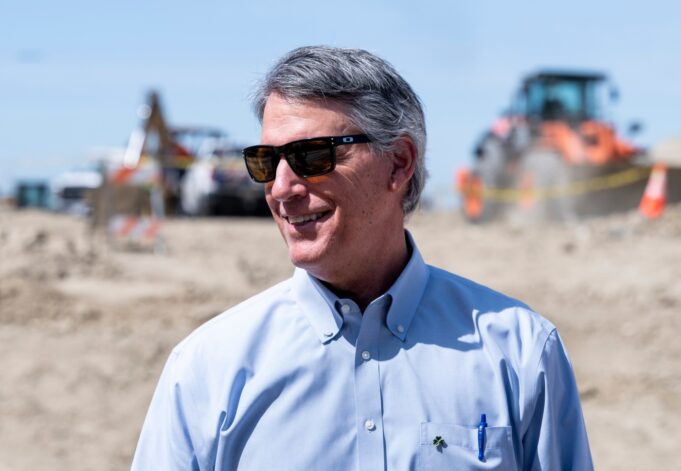Written by Jonathan Lansner
The entrance off El Toro Road and the 241 toll road are seen at a Trumark Homes development in Mission Viejo, CA on Thursday, March 17, 2022. Trumark Homes is grading property at the corner of El Toro Road and Marguerite Parkway to build 91 townhomes. (Photo by Paul Bersebach, Orange County Register/SCNG)
Travis Oden, Land Development Manager, Joe Martin, VP of Land Development and Southern California Division President Richard Douglass, from left, stand at a new development in Mission Viejo, CA on Thursday, March 17, 2022. Trumark Homes is grading property at the corner of El Toro Road and Marguerite Parkway to build 91 townhomes. (Photo by Paul Bersebach, Orange County Register/SCNG)
Grading is underway at a new development in Mission Viejo, CA on Thursday, March 17, 2022. Trumark Homes is building 91 townhomes at the corner of El Toro Road and Marguerite Parkway. (Photo by Paul Bersebach, Orange County Register/SCNG)
Travis Oden, Land Development Manager and Southern California Division President Richard Douglass, from left, look over a retaining wall at a new development in Mission Viejo, CA on Thursday, March 17, 2022. Trumark Homes is grading property at the corner of El Toro Road and Marguerite Parkway in Mission Viejo, CA to build 91 townhomes. (Photo by Paul Bersebach, Orange County Register/SCNG)
Travis Oden, Land Development Manager and Joe Martin, VP of Land Development, from left, look over a trap to store rainwater runoff at a new development in Mission Viejo, CA on Thursday, March 17, 2022. Trumark Homes is grading property at the corner of El Toro Road and Marguerite Parkway to build 91 townhomes. (Photo by Paul Bersebach, Orange County Register/SCNG)
Grading work continues at a new development in Mission Viejo, CA on Thursday, March 17, 2022. Trumark Homes is grading property at the corner of El Toro Road and Marguerite Parkway to build 91 townhomes. (Photo by Paul Bersebach, Orange County Register/SCNG)
This May 2022 drone view shows land in Mission Viejo of El Toro Road, where Trumark Homes is building 91 townhomes and condos on what was essentially an undeveloped hillside. The construction pad is essentially finished. (Courtesy: Trumark Homes)
This September 2021 drone view shows land in Mission Viejo of El Toro Road, where Trumark Homes is building 91 townhomes and condos on what was essentially an undeveloped hillside. This view is from shortly after grading began. (Courtesy: Trumark Homes)
Trumark Homes will sell in Irvine residences in its L’Aube at Solis Park neighborhood that are three stories high and range in size from 1,640 to 2,419 square feet with three or four bedrooms. Prices will start in the low-$1 million range. (Courtesy: Trumark Homes)
To understand the lengths some homebuilders go to in order to acquire land, consider the challenges for Trumark Homes as it develops 138 residences at two very different Orange County sites.
In Mission Viejo, Trumark is building 91 townhomes and condos on what was an undeveloped hillside.
At the same time 6 miles to the west in Irvine, the San Ramon-based developer is building 47 single-family houses on ready-to-go lots in the Great Park Neighborhoods’ master-planned community Solis Park.
For Trumark, both projects are a stretch from its reputation as a specialist in what industry insiders call “in-fill” projects — turning small city spaces into housing.
Such modest, urban housing projects — building new homes on vacant lots, aging shopping centers, old factories, and shuttered schools — require certain niche development skills. Plus, plenty of patience is required to gain construction approvals from local governments.
Building homes on raw real estate that’s been prepped by others in Irvine is a relative breeze for Trumark. But the high-level grading involved at the Mission Viejo construction pad has been unique.
“It’s the most technically challenging project of my career,” says Richard Douglass, president of Trumark’s Southern California operations who’s helped build over 11,000 homes in his three-plus decades in and around the home construction business. “We took what we know from our urban products and applied them here.”
On a mission
Pre-construction efforts at the two sites could not have been more different.
Trumark closed on the Mission Viejo land purchase in December 2020 — paying Saddleback Church $6.5 million for the excess property next to one of its administrative buildings. The money came in handy for the church, which was hurt by pandemic shutdowns and wanted to help needy members of its community.
What Trumark got was a 12.6-acre hillside with a noteworthy 150-foot drop from its peak down to El Toro Road.
Before and after drone photos of Trumark Homes’s grading at the Mission Viejo site where 91 townhomes will be built. (Courtesy: Trumark Homes)
Dirt didn’t move at the Mission Viejo site for nine months as Trumark finished a grading strategy. Seven more months were spent creating a 6-acre pad roughly 35 to 60 feet above the street where the homes will go.
Then, after the construction surfaces were finally molded to specifications this spring, digging began again. This summer, utilities and a street will be added to the home site. After all that prep work is complete, the homes can be constructed. Sales won’t start until early next year.
Now, let’s compare that with the Irvine project.
The land, bought in June 2021, had been graded to a point where construction of the homes could quickly begin. Lots and streets were shaped, with the main utility lines already at the site’s edge. Pre-sales activity began in May and the model homes should be ready by September.
What took so long?
Not only was the Mission Viejo property on a steep slope, but it’s also squeezed between a major thoroughfare, a church office building and parking lot, SoCal Edison power lines, and a condo community above it.
To create level land for construction, the back of the site had to be scooped out and dirt moved toward the street to lift the front of the property. That meant 357,000 cubic yards of earth had to be carted in tight quarters — or what adds up to 2,000 fill-ups of a triple-axle dump truck.
To keep the dirt in place, 48,000 square feet of brown-brick retaining walls had to be built.
Two of these structures overlooking the street — 15 and 36 feet high — are below the pad. A 20-foot wall at the back keeps the hill in place. And construction required 78,000 of sand — another 400-plus truckloads — brought to the site to meet wall-building specifications.
“It was as difficult as we thought,” Douglass says. “But that was better than being more difficult than we thought.”
The bottom line
It cost Trumark at least $15 million to do the Mission Viejo site prep work — more than double the purchase price. It adds up to roughly a $22 million cost for buildable land — or about $250,000 for each of the 91 residences planned.
Those townhomes at what will be called “Saddleback Place” will vary in size from 860 to 1,950 square feet, with one to three bedrooms. Projected pricing is from the high $500,000s to the high $700,000s.
In Irvine, Trumark couldn’t disclose its land costs. But it’s a safe bet the lot cost per home was likely double that of Mission Viejo.
At the Great Park, Trumark will construct bigger, detached homes to defray some of those higher land costs. Residences in its L’Aube at Solis Park neighborhood will be three stories high and range in size from 1,640 to 2,419 square feet with three or four bedrooms. Prices will start in the low-$1 million range.
So why would Trumark pay so much for the Irvine land?
Trumark Homes will sell in Irvine residences in its L’Aube at Solis Park neighborhood that are three stories high and range in size from 1,640 to 2,419 square feet with three or four bedrooms. Prices will start in the low-$1 million range. (Courtesy: Trumark Homes)
For starters, land to put houses on is hard to find in Orange County. So having various sources of lots is an important business factor.
Plus, as Douglass explains, it’s all about “portfolio management” — having a mix of risk-taking in a complex and dicey industry. Consider the hurdles a typical project faces.
First, there’s the entitlement: Can you get the land past various bureaucratic construction barriers?
Public input may limit what can be built, changing the plan’s finances. That process can also play havoc with timing. Don’t forget, time is very much money when you’ve invested cash into land that isn’t actively being developed.
This could have been a big issue in Mission Viejo in 2020. But the city, mid-pandemic, was a “great partner,” Douglass says.
In Irvine, the Great Park’s master developer, Five Point Holdings, had taken on the entitlement risk.
Also, think about development risk — putting the pieces together to go from approved building plans to getting started.
It’s not simple to create a plan to corral the financial backing for a project — especially for an unusual effort like Mission Viejo, where the development costs far exceeded the land price.Related Articles
Housing |
Former Industry city manager allegedly paid out $8.5 million without approval
Housing |
With Great Park residents frustrated, city proposes ‘task force’ to get their voice in development
The finish line
Both projects face two other common homebuilder risks — what can go wrong once dirt starts moving.
The act of homebuilding itself is tricky, especially in supply-short 2022. Do you have the staffing and building materials to make construction run smoothly — and meet a cost budget?
And finally, there’s the obvious gamble: selling the homes. This seemed an easy chore when 2022 started — back before mortgage rates soared and the economy started to look choppy.
This collection of challenges can be amplified when projects can take years to get to market. What house hunters want — and what price they’ll pay — is by no means a guaranteed slice of this equation.
Getting to the finish line — profitably turning real estate into residences — is no sure bet. That’s an often forgotten slice of the grand debate over housing supply.
“We have the ability and tolerance to go after these riskier projects,” Trumark’s Douglass says. “Not every builder will do that.”
Jonathan Lansner is business columnist for the Southern California News Group. He can be reached at jlansner@scng.com
Source: OC Register











